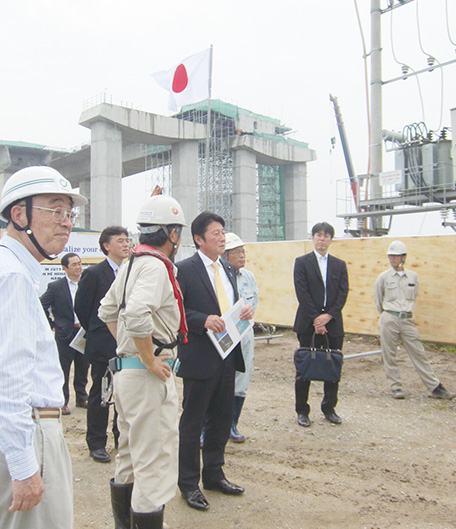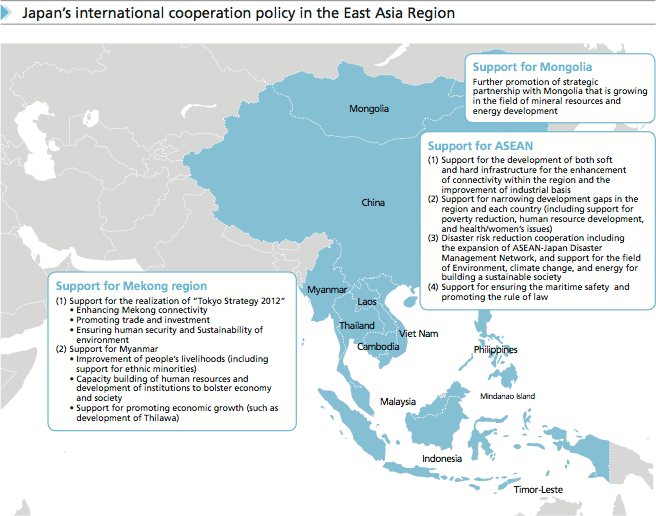Japan's Official Development Assistance White Paper 2013
1. East Asia
East Asia consists of a variety of nations: countries such as Republic of Korea and Singapore, which have attained high economic growth and have already shifted from aid recipients to donors; least developed countries (LDCs) such as Cambodia and Laos; countries such as China, which still has internal disparities despite its dramatic economic growth; and countries such as Viet Nam, which is in the process of transitioning from a centrally planned economy to a market economy. Japan has close relationships with these countries in all aspects of politics, economy, and culture, so the development and stability of the region significantly impacts the security and prosperity of Japan as well. From this perspective, Japan is engaging in development cooperation activities, responding to not only the diverse socio-economic circumstances of East Asian countries but also to the changes in the type of needed development cooperation.
<Japan’s Efforts>
Japan has contributed to the remarkable economic growth in East Asia by implementing development cooperation that combines ODA with trade and investment, including the improvement of infrastructure, development of systems and human resources, promotion of trade, and revitalization of private investment. Currently, Japan is aiming to further enhance open regional cooperation and integration while sharing basic values, to promote mutual understanding, and to maintain consistent regional stability. Therefore, Japan has made efforts to respond proactively to transnational problems such as natural disasters, environment and climate change, infectious diseases, terrorism and piracy and others, in parallel with the assistance for developing infrastructure to date. Japan is also working to promote mutual understanding through large-scale youth exchanges, cultural exchanges, and projects to disseminate Japanese language education.
Although the impact of the global financial and economic crisis which started in 2008 has largely been overcome in East Asia, in order for Japan and other Asian countries to achieve further economic prosperity, it will be important to assist Asia to become “a center of growth open to the world.” Accordingly, Japan is providing assistance to strengthen Asia’s growth and to expand domestic demand in each country.
In April 2009, Japan announced that it would provide up to ¥2 trillion of ODA as a specific measure to assist the Asian region. (Note 1) In light of that pledge, Japan is consistently providing support for infrastructure development, assistance towards socially vulnerable people, building low-carbon societies, and human resource development. In addition, in the area of food security, under the ASEAN+3 framework, the ASEAN Plus Three Emergency Rice Reserve (APTERR) agreement, took effect in July 2012 as a preparatory measure for emergencies such as large-scale disasters. Through this framework, emergency assistance taking advantage of contributions from Japan was provided to the victims of a typhoon that hit the Philippines in December 2012. In this way, Japan is strengthening regional cooperation in Southeast Asia.
●Support for Southeast Asia
Members of the Association of Southeast Asian Nations (ASEAN) (Note 2) are aiming for establishment of the ASEAN community by 2015. Japan has continued to assist the enhancement of ASEAN connectivity and in narrowing the development gap within ASEAN. In particular, support for the Mekong countries (Note 3), which include more low income countries than the other areas of ASEAN, is important for reducing intraregional disparities as well.
On the occasion of the first-ever Mekong-Japan Summit Meeting held in November 2009, the representatives from participating countries gained a shared recognition regarding the Establishment of a New Partnership for the Common Flourishing Future and strengthening measures based on the following three pillars: (i) comprehensive development in the Mekong region; (ii) environment and climate change (launch of the “A Decade towards the Green Mekong” initiative), and overcoming vulnerability; and (iii) expansion of cooperation and exchanges. To promote these efforts, Japan announced that it would expand ODA, particularly to Cambodia, Laos, and Viet Nam, and the entire Mekong region, with more than ¥500 billion of ODA in the next three years.
In response to this continued support, the leaders at the Fourth Mekong-Japan Summit Meeting in April 2012 adopted the new Tokyo Strategy 2012 for Mekong-Japan Cooperation, which is a new cooperation policy until 2015, based on the three pillars: (i) enhancing Mekong connectivity; (ii) developing together; and (iii) ensuring human security and environmental sustainability. Japan announced that it would provide ¥600 billion of ODA over the three years starting in 2013 to steadily implement the Tokyo Strategy. Japan also adopted the Mekong-Japan Action Plan that describes specific actions and measures to realize the Tokyo Strategy 2012 at the Fifth Mekong-Japan Foreign Ministers’ Meeting in July 2012 in Phnom Penh, Cambodia.
Among the Mekong region countries, democratization is rapidly progressing especially in Myanmar. In April 2012, Japan announced that it would review its economic cooperation policy and provide a wide range of assistance to Myanmar to backup the rapid progress of its reform efforts. Japan has been actively providing various kinds of assistance to Myanmar, including its arrears clearance operation of Myanmar’s delinquent debt of ¥500 billion, the resumption of the provision of ODA loans, and the provision of a total of ¥91 billion assistance such as new ODA loans that Japan committed itself to implement by the end of FY2013.
In addition to promoting such efforts, Japan is providing support in promoting ASEAN economic integration, with poverty reduction and narrowing the development gap within ASEAN. Further, at the ASEAN Summit Meeting held in October 2010, ASEAN adopted the Master Plan on ASEAN Connectivity* aiming at intensifying physical connectivity, institutional connectivity and people-to-people connectivity in the region. Japan is utilizing ODA and public-private partnership (PPP) to provide proactive assistance to put the Master Plan into action.

Former Parliamentary Senior Vice-Minister for Foreign Affairs Masaji Matsuyama visiting the construction site of the Nhat Tan Bridge in Viet Nam.
At the ASEAN-Japan Summit in November 2011, Japan announced a “List of flagship projects for enhancing ASEAN connectivity”, with fund procurements utilizing public funds from ODA and the Japan Bank for International Cooperation (JBIC) with consideration given to ways of mobilizing private-sector funds. As 2013 marks the 40th Year of ASEAN-Japan Friendship and Cooperation, and the ASEAN-Japan Commemorative Summit Meeting was held in December in Tokyo. The mid- to long-term vision for strengthening the Japan-ASEAN relationship was issued during this summit meeting. It is expected that the cooperation between Japan and ASEAN will be further promoted to strengthen ASEAN connectivity. Moreover, Japan has been contributing to peacebuilding efforts, including through its intensive support for the conflict affected areas in Mindanao in the Philippines and assistance for nation-building in Timor-Leste.
In terms of disaster risk reduction, in addition to bilateral cooperation, Japan provides assistance for ASEAN based on the Disaster Management Network for ASEAN Region that Japan proposed in July 2011. Assistance is provided mainly to strengthen the capabilities of the ASEAN Coordinating Centre for Humanitarian Assistance on Disaster Management (AHA Centre), which is a disaster response and disaster risk reduction organization for ASEAN.
Japan has strengthened its partnership with the Asian Development Bank (ADB), which works on a variety of regional cooperative initiatives in the Asia region. For example, Japan contributed up to $25 million over five years to the ADB for trade facilitation in Asia. Japan has also strengthened its partnership with the Economic Research Institute for ASEAN and East Asia (ERIA), an international research organization in East Asia, including cooperation towards implementation of the Comprehensive Asian Development Plan and the Master Plan on ASEAN Connectivity.
Further, on the financial front in particular, Japan has taken the lead in implementation of the Chiang Mai Initiative (CMI)* within the ASEAN+3 (Japan, China, Republic of Korea) framework. This initiative is designed to prevent a chain reaction of currency crises and its expansion by means of providing short-term foreign currency financing for countries in which critical circumstances have arisen, such as obstacles arising in their foreign currency payments due to precipitous outflows of capital. In March 2010, the former CMI framework, a network of bilateral agreement between related authorities, was integrated into one framework for multiple countries (the Chiang Mai Initiative Multilateralization Agreement [CMIM Agreement]). This enabled faster response to the international balance of payments within the ASEAN+3 regions as well as to the difficulties with liquidity in short-term financing, thereby strengthened the capacity to deal with the risks and challenges of an expanding global economy.
Furthermore, the ASEAN+3 Finance Ministers and Central Bank Governors’ Meeting in May 2012 agreed to radically strengthen the CMIM, such as doubling the size of the CMIM from $120 billion to $240 billion, implementing crisis prevention facility, and accelerating the preparation of the ASEAN+3 Macroeconomic Research Office (AMRO)*, an institution that monitors and analyzes the regional economy, to be transformed to an international organization. At the ASEAN+3 Finance Ministers and Central Bank Governors’ Meeting in May 2013, a basic consensus was reached on the draft of a proposed agreement for transforming the AMRO to an international organization. It is expected that these efforts will contribute to stabilizing the regional and global finance and economy.
Further, in addition to the CMIM, Japan has taken the lead in efforts to foster the bond market of ASEAN+3 (Asian Bond Markets Initiative [ABMI]). In particular, the decision was made to establish the Credit Guarantee and Investment Facility (CGIF) as an ADB trust fund, to guarantee bonds issued by the companies of ASEAN+3 in local currencies, with initial capital of $700 million, and in April 2013 the first bond guaranteed by the CGIF was issued. The CGIF is expected to contribute to the expansion of local currency bond trading in the region and the growth of the regional economy.
Glossary
- *Master Plan on ASEAN Connectivity
- A plan adopted at the October 2010 ASEAN Summit to enhance connectivity towards building of the ASEAN Community by 2015. This enhancement focuses on 3 types of connectivity: physical connectivity (transport, ICT, energy networks, etc.), institutional connectivity (liberalization and facilitation of trade, investment, services, etc.), and people-to-people connectivity (tourism, education, culture, etc.).
- *Chiang Mai Initiative (CMI)
- An agreement for local financial cooperation adopted by ASEAN+3 (Japan, China, Republic of Korea). It is a mechanism to assist countries in East Asia that have experienced an economic crisis and suffer a dramatic shortage of foreign currency, by exchanging dollars held as a foreign reserve by each Asian country into the currency of that country, to make up for shortages in foreign currency.
- *ASEAN+3 Macroeconomic Research Office (AMRO)
- The establishment of AMRO was agreed at the ASEAN+3 Finance Ministers Meeting in May 2010 in Tashkent based on the recognition of the importance of improving regional economic surveillance to make Chiang Mai Initiative decision-making easier and more efficient. The office was established in Singapore in April 2011.
Note 1: “Growth Initiative towards Doubling the Size of Asia’s Economy“
Note 2: ASEAN countries: Brunei, Cambodia, Indonesia, Laos, Malaysia, Myanmar, Philippines, Singapore, Thailand, and Viet Nam
Note 3: Mekong countries: Cambodia, Laos, Myanmar, Thailand, and Viet Nam
●Indonesia
Master Plan Study for Establishing Metropolitan Priority Area for Investment and Industry (MPA) in JABODETABEK Area
Preparatory Survey (May 2011 - May 2012)
In December 2010, Japan and Indonesia agreed on the concept of the Metropolitan Priority Area for Investment and Industry (MPA) in JABODETABEK Area in order to improve the investment environment of the Jakarta metropolitan area*, and drive further economic development in Indonesia. The Jakarta metropolitan area is extremely important with more than 10% of the Indonesian population residing in the area. Exports from the Jakarta metropolitan area account for 60% of Indonesian exports. In October 2012, the MPA Steering Committee, consisting of government officials from both Japan and Indonesia, approved the MPA (Metropolitan Priority Area) Strategic Plan, which was developed with Japan’s assistance. Both countries also agreed to work together on the following: (1) the formulation of a city vision for Jabodetabek in 2020; (2) the formulation of a Jabodetabek infrastructure development plan by 2020, which includes 45 priority projects; and (3) the commencement of 18 Fast Track Projects for the 45 priority projects, which are scheduled to start by the end of 2013.
Many of the Fast Track Projects include projects that will be undertaken using Japanese ODA. These include: the development of the north-south line of the Mass Rapid Transit railway (MRT), which will be the first subway in Indonesia; the Java-Sumatra Interconnection Transmission Line Project, a high capacity electricity supply line between Java and Sumatra Islands to supply electricity to Jabodetabek; and the reconstruction of the Pluit pump station for flood protection of Jakarta.
These projects are symbolic of the mutually beneficial economic relationship between Japan and Indonesia. It is anticipated that with the cooperation of the public and private sectors of both countries, the projects will bring significant benefits to both countries.
* Jakarta metropolitan area includes Jakarta, Bogor, Depok, Tangerang and Bekasi.

An image of a train station development project (Photo: JICA)
●Thailand
Project on Long-term Care Service Development for the Frail Elderly and Other Vulnerable People
Technical Cooperation Project (January 2013 - Ongoing)
As medical standards improve and birthrates decline, the aging of the population in Thailand has accelerated rapidly. With the rate of people aged 65 years or over accounting for around 8.9% of the population, Thailand is already classified as an aging population nation (7% of the country’s population is aged 65 or over). Furthermore, it is estimated that Thailand’s transition from an “aging society” to an “aged society” (14% of the entire population is aged 65 or over) will take 23 years, shorter than Japan’s 24 years.
Moreover, as young people move to urban areas for employment and as social structures change with nuclear family households becoming increasingly common, the number of senior households is increasing and the number of families looking after their elderly family members is decreasing. Additionally, it is expected that the number of elderly requiring care will further increase. This has given rise to a demand for more organized nursing care capabilities provided as a public service rather than relying on conventional care provided by family members and volunteer workers. In light of this, through the Project on Long-term Care Service Development for the Frail Elderly and Other Vulnerable People, Japan provides support for the development of a financially and technically sustainable care service model.
The project involves the development and provision of care services and the development of training programs for caregivers at six locations (regions) across Thailand. Under these initiatives, Thai policymakers responsible for elderly care and Thai caregivers are invited to Japan to receive elderly welfare administrative training and practical nursing skills training. In autumn 2013, it is expected that elderly care services tailored to each location will be launched.
Through the implementation and assessment of the model elderly care services and the provision of training to caregivers, Japan will provide recommendations to the Thai government on policies in relation to elderly services and schemes. Furthermore, Japan plans to hold international seminars to share the experiences of Thailand with other ASEAN member nations.
(As of August 2013)

A short-term expert creating a care plan for an elderly in Surat Thani Province (Photo: Yoko Isobe)
●Relations with China
Since 1979, ODA to China has contributed to maintaining and promoting the Reform and Opening Up Policy of China, and at the same time, it has formed a strong foundation to support Japan-China relations. The Chinese economy has seen stable development through assistance for the development of economic infrastructure. This has contributed to the stabilization of the Asia-Pacific region, as well as the improvement of China’s investment environment for Japanese companies and the development of economic relations between Japanese and Chinese private sectors. On a variety of occasions, the Chinese side has expressed high appreciation and gratitude towards Japan’s ODA, for example, at the Japan-China Summit Meeting in May 2008, when then-Chinese President Hu Jintao expressed his sincere gratitude.
On the other hand, China has developed economically, and has seen an increase in its technological level. China’s own fund-raising capacity and the flow of private capital have also increased significantly. Thus, assistance for China through ODA has already fulfilled its role to a certain degree. As for the ODA loans that accounted for the majority of ODA to China, Japan and China commonly recognized that new disbursement of ODA loans to China would come to an amicable conclusion by the time of the 2008 Beijing Olympics, which symbolized the economic and social development of China. Following this, such new disbursement ended with the signing of Exchanges of Notes for the projects in December 2007.
Based on the fact that ODA to China has already fulfilled its role to a certain degree, at present, ODA to China is limited to address common challenges faced by both countries that may directly affect the lives and safety of Japanese nationals (for example, measures against cross-border pollution to Japan, yellow sand, infectious diseases, and safety of food), that are beneficial to Japan.


